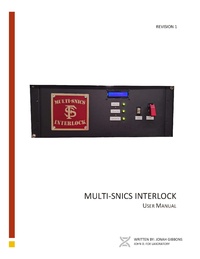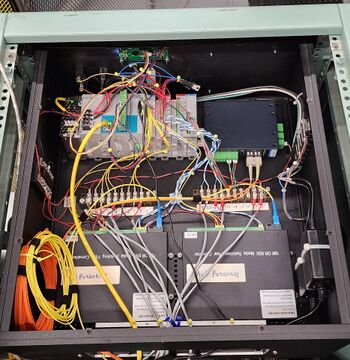Triton Beam Project
The Triton Beam Project is aiming to establish a triton-beam capability for the FSU accelerator. Its main components are a dedicated injector with a Multi-Cathode Source of Negative Ions by Cesium Sputtering (Multi-SNICS), which will provide triton beams from tritium-loaded titanium cathodes.
Main components of the Multi-SNICS triton injector: Triton Injector
Interlock
OverviewThe Multi-SNICS has several very high voltage power supplies, a high vacuum chamber, several types of pumps, and is designed to work with tritium embedded cathodes. Tritium is a radioactive isotope of hydrogen that poses a significant health risk if ingested, inhaled, or absorbed into the body. To operate the Multi-SNICS safely, a comprehensive safety plan is required. Part of the plan is an Interlock System that acts as a fail-safe mechanism, actively monitoring key parameters such as closure of the cage doors surrounding the source, leaking tritium detection, vacuum pressure, building power, coolant flow, and smoke detection. In the event of deviations from safe operating conditions, the Interlock System initiates automatic shutdown procedures, preventing potential harm to personnel, the environment, and the equipment itself. |
Equipment
The Interlock System is based on a P1AM ProductivityOpen PLC controller. It has industrial grade ratings to endure harsh environments. There are a lot of options for modules that snap together and communicate on a Modbus. The expandability of this platform makes it a good choice for this application because it can evolve to meet new needs in the future. A raspberry pi 4B is connected to the Arduino, provides a programming interface, read-out of the serial port (USB), and pipe the reading to the database in fsunuc.physics.fsu.edu.
ProductivityOpen ControllerThe Interlock System uses the following P1AM series modules:
Main Power SupplyThere is a Mean Well USA Inc AC/DC converter that converts 120 VAC to 24 VDC and is used to power everything in the rack-mounted enclosure. |
|
Fiber Optic Isolation
The ion source has two high-voltage regions that must be electrically isolated to prevent a short circuit. The regions are each referred to as the high and mid-potential regions respective of their relative voltage potential. Each region has a fiber optic link to relay contact closures or analog signals between the Interlock System and the sensors and control devices.
- Interlock System Enclosure (Ground Potential):
- • 2x Bidirectional contact closure fiber transceivers
- • Analog voltage signal fiber receiver
- Mid-potential Area:
- • Bidirectional contact closure fiber transceiver
- • Analog voltage signal fiber transmitter
- High-potential Area:
- • Bidirectional contact closure fiber transceiver
LCD Screen
The screen is a commonly used 1602 LCD module with a built in HD44780 controller. It can display 2 lines of up to 16 characters. It receives display commands from the P1AM- GPIO shield.
Sensors
- • Cage door contacts
- • Fume hood flow switch
- • Vacuum gauge threshold relays
- • Vacuum gauge analog output
- • Tritium detector threshold relay
- • Tritium detector analog output
- • Building power monitor relay
- • Coolant flow switches
- • Smoke detector
- • Titanium sublimation pump analog output
Firmware
The P1AM-100 controller uses Arduino IDE or ProductivityBlocks for programming. For this project, the firmware was written in C++.
The source code is here https://fsunuc.physics.fsu.edu/git/jgibbons3/Multi-SNICS_Interlock.git
Trouble Modes
Each of the sensors monitored by the interlock system are mapped to an appropriate response state to shutdown or lock out the Multi-SNICS injector and its power supplies in the event of an irregularity or trouble.
| Cage Door Trip | Vacuum Trip | Source Trip | |
|---|---|---|---|
| Input Conditions | Cage Door Contact | Vacuum Condition (Gnd) Vacuum Condition (Mid) |
Emergency Source Trip Switch Fume Hood Flow Switch Tritium Monitor Relay Building Power Failure Relay Smoke Detector |
| Output Relays | Pre-accelerator Supply Off Other High-Power Supplies Off |
Pre-accelerator Supply Off Other High-Power Supplies Off Both Gate Valves Closed Ionizer Off |
Pre-accelerator Supply Off Other High-Power Supplies Off Both Gate Valves Closed Ionizer Off Boiler Off |
Contact
| Primary Contact: | Ingo Wiedenhoever mailto:iwiedenhoever@fsu.edu | |
| Interlock: | Jonah Gibbons mailto:jgibbons3@fsu.edu Ryan Tang mailto:rtang@fsu.edu |

